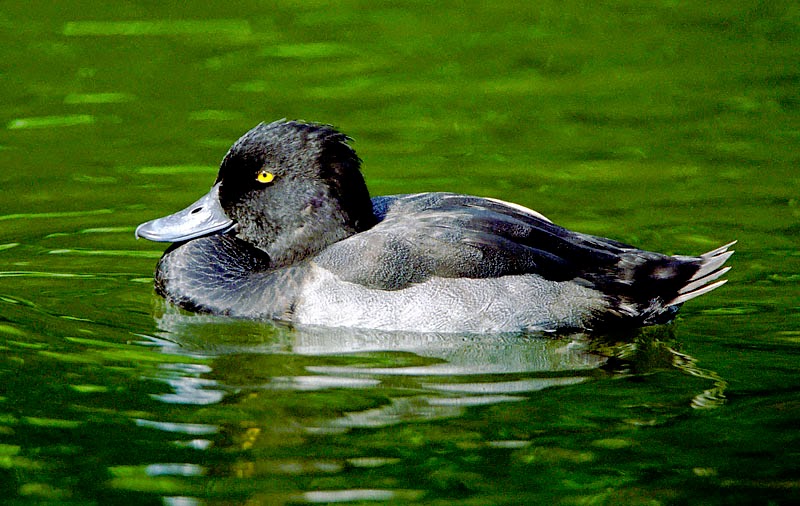Tufted Duck x Greater Scaup hybrid, Malmoe (Sweden), probably spring 2002 - copyright Carl Gunnar Gustavsson
(photo ID: 1077)
This bird is close to Tufted Duck in appearance but with its finely vermiculated dark grey (not black) back it can't be a pure Tufted Duck. Although not proven its appearance seems to be consistent with Tufted Duck x Greater Scaup hybrid. Carl Gunnar has learned that some ducklings were seen nearby a few years earlier which were suspected of being female Scaup x male Tufted Duck.
Tufted Duck x Greater Scaup hybrid (same bird as in photo ID 1077), Malmoe (Sweden), probably spring 2002 - copyright Carl Gunnar Gustavsson
(photo IDs: 1078-1081)
This female was seen in the same area the same summer. The bill tip pattern doesn't seem quite right for a pure Greater Scaup and it's probably another hybrid.
probable Tufted Duck x Greater Scaup hybrid, Malmoe (Sweden), probably summer 2002 - copyright Carl Gunnar Gustavsson
(photo IDs: 1074-1076)
The next bird is probably the same male as shown above (photo IDs 1077-1081), but in partial eclipse plumage.
Tufted Duck x Greater Scaup hybrid (probably same bird as in photo IDs 1077-1081), Malmoe (Sweden), uncertain date - copyright Carl Gunnar Gustavsson
(photo IDs: 1082-1087)
The next bird is captive but spent the whole duration of Joern's visit asleep, preventing him from seeing the bill pattern or iris colour. The only candidate parent species kept at the zoo were Common Pochard, Tufted Duck and Greater Scaup. Joern explains:
"The general coloration is somewhat similar to Greater Scaup, but the mantle is a bit darker. There is a bump of feathers or a short crest at the rear of the head, indicating Tufted Duck involvement. Tufted Duck x Common Pochard can look superficially similar, but in general the flanks of this type of hybrid are slightly greyish and the vermiculations on the mantle are less course than here. Therefore in my opinion this bird is most likely a hybrid Tufted Duck x Greater Scaup."
probable Tufted Duck x Greater Scaup hybrid, Zoo Köln (Germany), 2nd November 2012 - copyright Joern Lehmhus
(photo ID: 0570)
It was interesting to see how the darkness of the upperparts on the next bird varied according to the angle of the bird and different light conditions. When I first picked it up it looked as pale as a Scaup but quickly morphed into a darker-looking beast. It never looked as dark as some of the photos above though. Noticeably larger than Tufted Ducks it was accompanying making the Scaup parent Greater. The vermiculations on the upperparts are not clearly visible in the photos but were easily seen in the field, albeit much less obvious than on either Scaup species, especially Lesser.
Tufted Duck x Greater Scaup hybrid, Lound Lakes (Norfolk/Suffolk border, UK), 7th March 2017 - copyright Dave Appleton
(photo IDs: 3130-3136)
Female Tufted Ducks with a lot of white around the bill and little or no tuft showing are often touted as possible Tufted Duck x Scaup hybrids (or even misidentified as pure Scaup) but in most cases they are just Tufted Ducks. The bird below differed from these in that I got a good clear look at the head over a period of time and its feathers were ruffled and raised sufficiently for me to establish that it certainly did not have an elongated tuft, rather than this simply not being visible. Moreover the structure seemed quite Scaup-like, although it was as small as a Tufted Duck. At some angles the upperparts and flanks seemed to lack any grey feathering (although they were paler than on the accompanying Tufted Ducks) but at some angles there seemed to be a distinct greyish tone to upperparts and flanks. Some photos seem to hint at an extensive dark tip to the bill as on Tufted Duck but in the field this seemed to be lacking - it certainly was not as obvious as it often is on Tufted Duck.
Unfortunately poor light, my longest lens being away for repairs and my general lack of technical skill mean that the photos I took are all quite poor.
probable Tufted Duck x Greater Scaup hybrid (with Pochard), Salhouse Broad (Norfolk, UK), 1st January 2013 - copyright Dave Appleton
(photo IDs: 0483-0487)
Next up are a male and a female on consecutive days:
Tufted Duck x Greater Scaup hybrid (with Tufted Ducks), Moellekrog (Denmark), 25th October 2004 - copyright Rasmus Strack
(photo ID: 0906)
Tufted Duck x Greater Scaup hybrid, Lake Esrom (Denmark), 26th October 2004 - copyright Rasmus Strack
(photo ID: 0905)
Joern Lehmhus has written about Tufted Duck x Greater Scaup hybrids in the German magazine Aves. The text is in German but non-German speakers may still be interested as it's accompanied by a number of photos of Tufted Duck x Greater Scaup hybrids. You can access the PDF of Aves 3 (2012) - the article starts on page 32 with section 2 on this hybrid beginning at page 35 - the five photos captioned "Reiherente x Bergente" are Tufted Duck x Greater Scaup hybrids.
Greater Scaup Aythya marila























+L.JPG)
+L.JPG)
+L.JPG)
+L.JPG)
+L.JPG)


+L.JPG)
+L.JPG)
+L.JPG)
+L.JPG)
+L.JPG)
+L.JPG)
+L.JPG)
+L.JPG)
+L.JPG)
+L.JPG)
+L.JPG)
+L.JPG)
+L.JPG)
+L.JPG)
+L.JPG)




+L.JPG)
+L.JPG)
+L.JPG)
.JPG)
.JPG)
+L.JPG)
+L.JPG)
+L.JPG)
+L.JPG)
+(1)+L.JPG)
+(2)+L.JPG)
+(4)+L.JPG)
+(5)+L.JPG)
+(7)+L.JPG)
+(8)+L.JPG)
+(9)+L.JPG)
+(1)+L.JPG)
+(2)+L.JPG)
+(3)+L.JPG)








